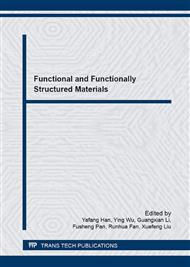[1]
C. Aksel, The role of fine alumina and mullite particles on the thermomechanical behaviour of alumina–mullite refractory materials, Mater. Lett. 57 (2002) 708-714.
DOI: 10.1016/s0167-577x(02)00858-3
Google Scholar
[2]
I.A. Aksay, J.A. Pask, The silica-alumina system: stable and metastable equilibria at 1. 0 atmosphere, Science. 183 (1974) 69-71.
DOI: 10.1126/science.183.4120.69
Google Scholar
[3]
J. Ossaka, Tetragonal mullite-like phase from co-precipitated gels, Nature. 191 (1961) 1000-1001.
DOI: 10.1038/1911000a0
Google Scholar
[4]
A.R. Guo, J.C. Liu, Y. Wang, H. Xu, Preparation of porous lamellar mullite ceramics with whisker skeletons by electrospinning and pressure molding, Mater. Lett. 74 (2012) 107-110.
DOI: 10.1016/j.matlet.2012.01.080
Google Scholar
[5]
B.M. Kim, Y.K. Cho, S.Y. Yoon, R. Stevens, H.C. Park, Mullite whiskers derived from kaolin, Ceram. Int. 35 (2009) 579-583.
DOI: 10.1016/j.ceramint.2008.01.017
Google Scholar
[6]
C. Duran, Y. K. Tur, Templated grain growth of textured mullite/zirconia composites, Mater. Lett., 59 (2005) 245-249.
DOI: 10.1016/j.matlet.2004.07.058
Google Scholar
[7]
M.F. Souza, J. Yamamoto, I. Regiani, Mullite whiskers grown from erbia-doped aluminum hydroxide-silica gel, J. Am. Ceram. Soc. 83 (2000) 60-64.
DOI: 10.1111/j.1151-2916.2000.tb01148.x
Google Scholar
[8]
H. Katsuki, H. Ichinose, S. Furuta, Growth of mullite whiskers on alumina particle by thermal decomposition of clay minerals, J. Ceram. Soc. Jpn. 104 (1996) 788-791.
DOI: 10.2109/jcersj.104.788
Google Scholar
[9]
J.R. Moyer, N.N. Hughes, A catalytic process for mullite whiskers, J. Am. Ceram. Soc. 77 (1994) 1083-1086.
Google Scholar
[10]
K. Okada, N. Ōtsuka, Synthesis of mullite whiskers by vapour-phase reaction, J. Mater. Sci. Soc. 8 (1989) 1052-1054.
DOI: 10.1007/bf01730484
Google Scholar
[11]
W.H. Jiang, Y.F. Peng, J.M. Liu, Preparation of mullite whisker via non-hydrolytic sol-gel route, J. Inorg. Mater. 25 (2010) 532-536.
DOI: 10.3724/sp.j.1077.2010.00532
Google Scholar
[12]
B.Q. Zhu, X.D. Li, R. Hao, Synthesis of mullite whisker in molten sodium sulphate, Refractory (in Chinese), 40 (2006) 165-168.
Google Scholar
[13]
L.L. Hench, J.K. West, The sol-gel process, Chem. Rev. 90 (1990) 33-72.
Google Scholar
[14]
W.H. Jiang, H.Y. Wei, G. Feng, Effect of oxygen donor alcohols on low temperature nonhydrolytic sol-gel synthesis of aluminum titanate, J. Chin. Ceram. Soc. 36 (2008) 11-16.
Google Scholar
[15]
W.S. Brower, H.S. Park, R.S. Roth, Phase equilibrium and crystal growth in the system lithium oxide-molybdenum oxide, J. Cryst. Growth. 16 (1972) 15-20.
DOI: 10.1016/0022-0248(72)90101-7
Google Scholar


